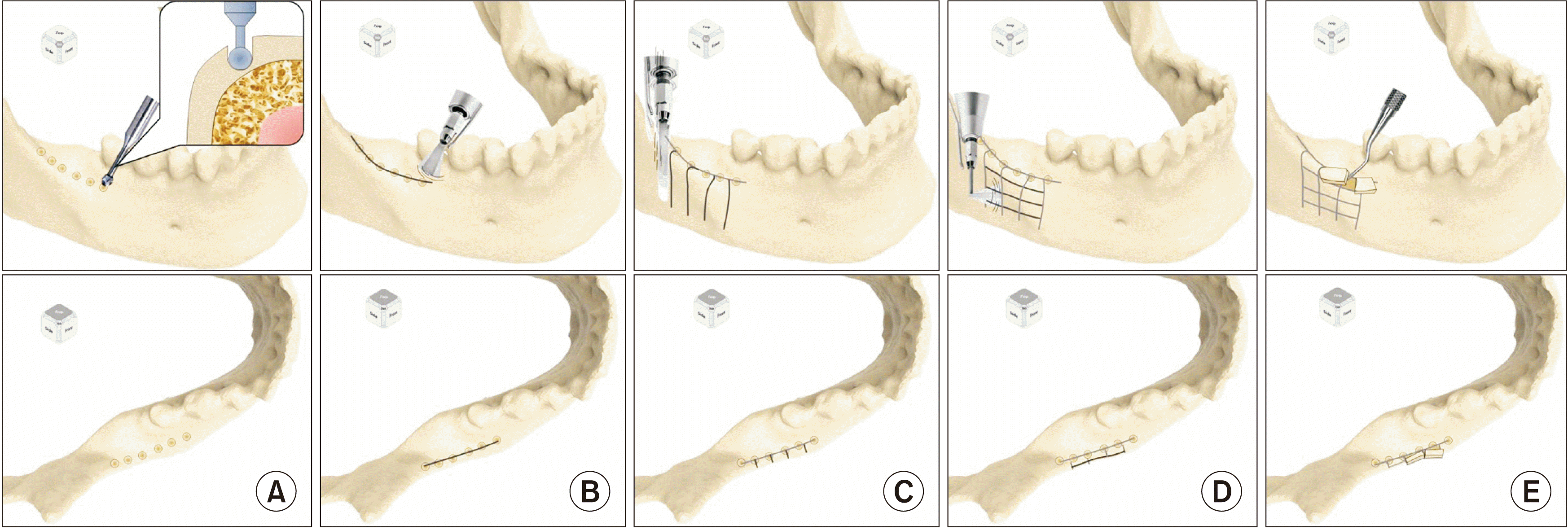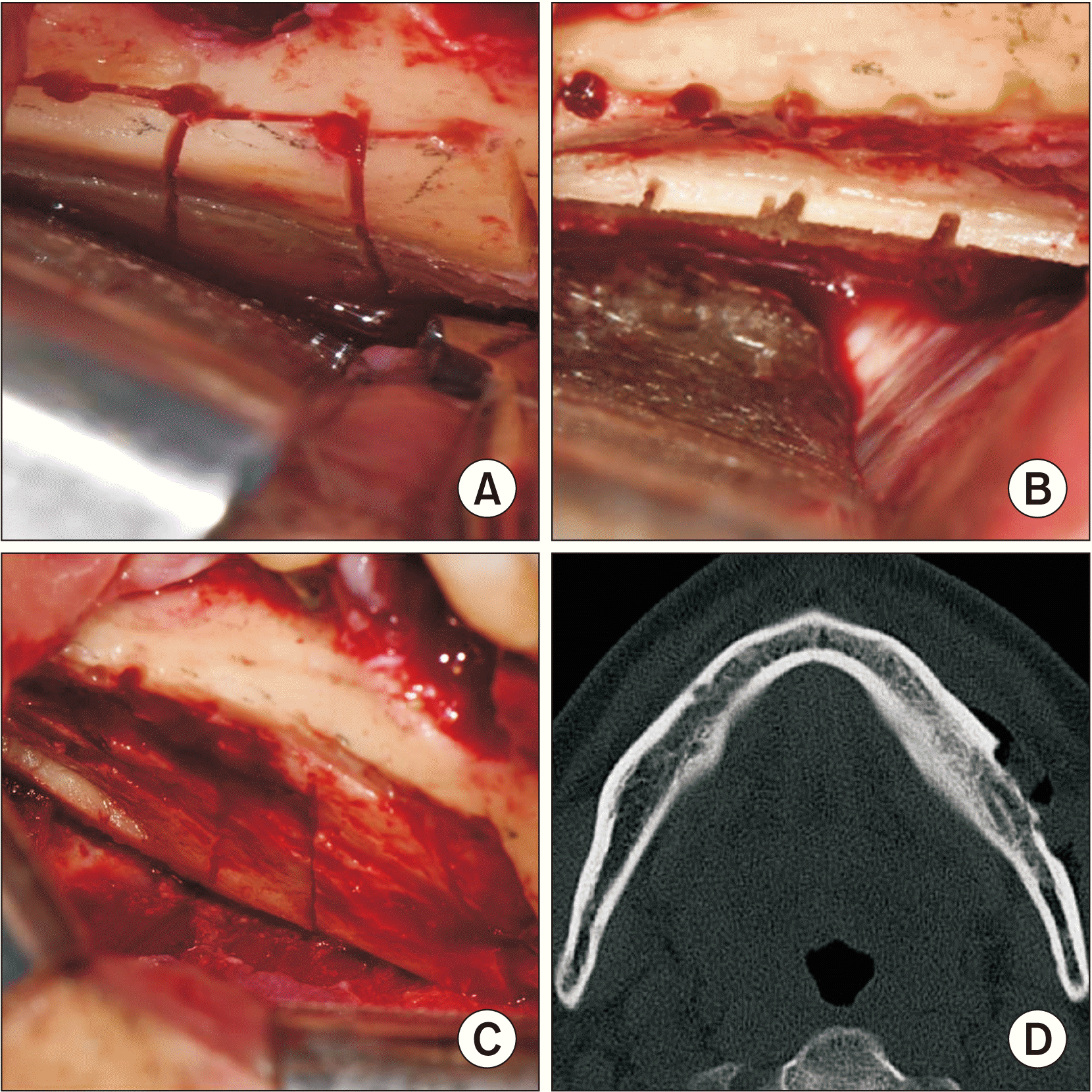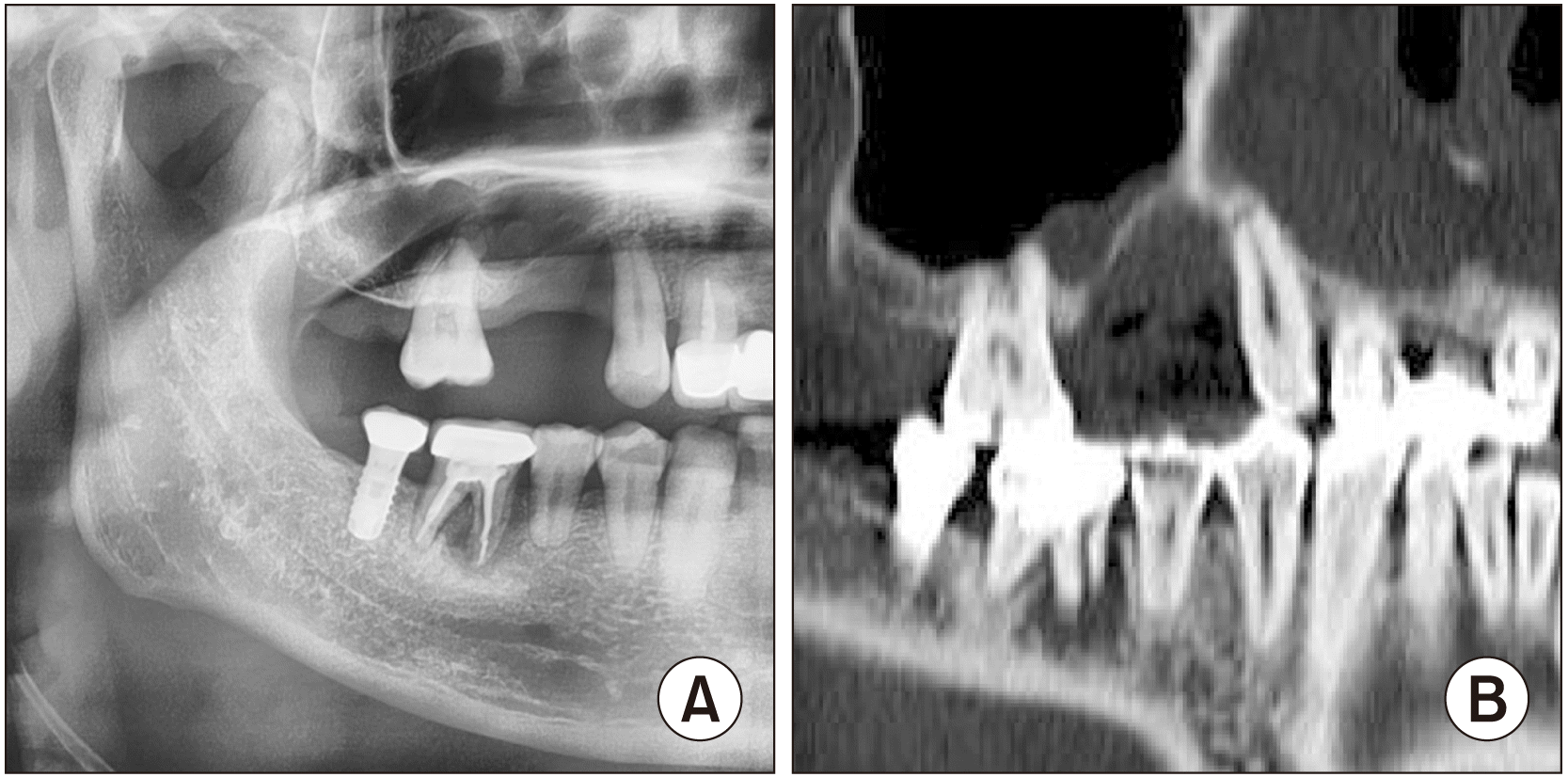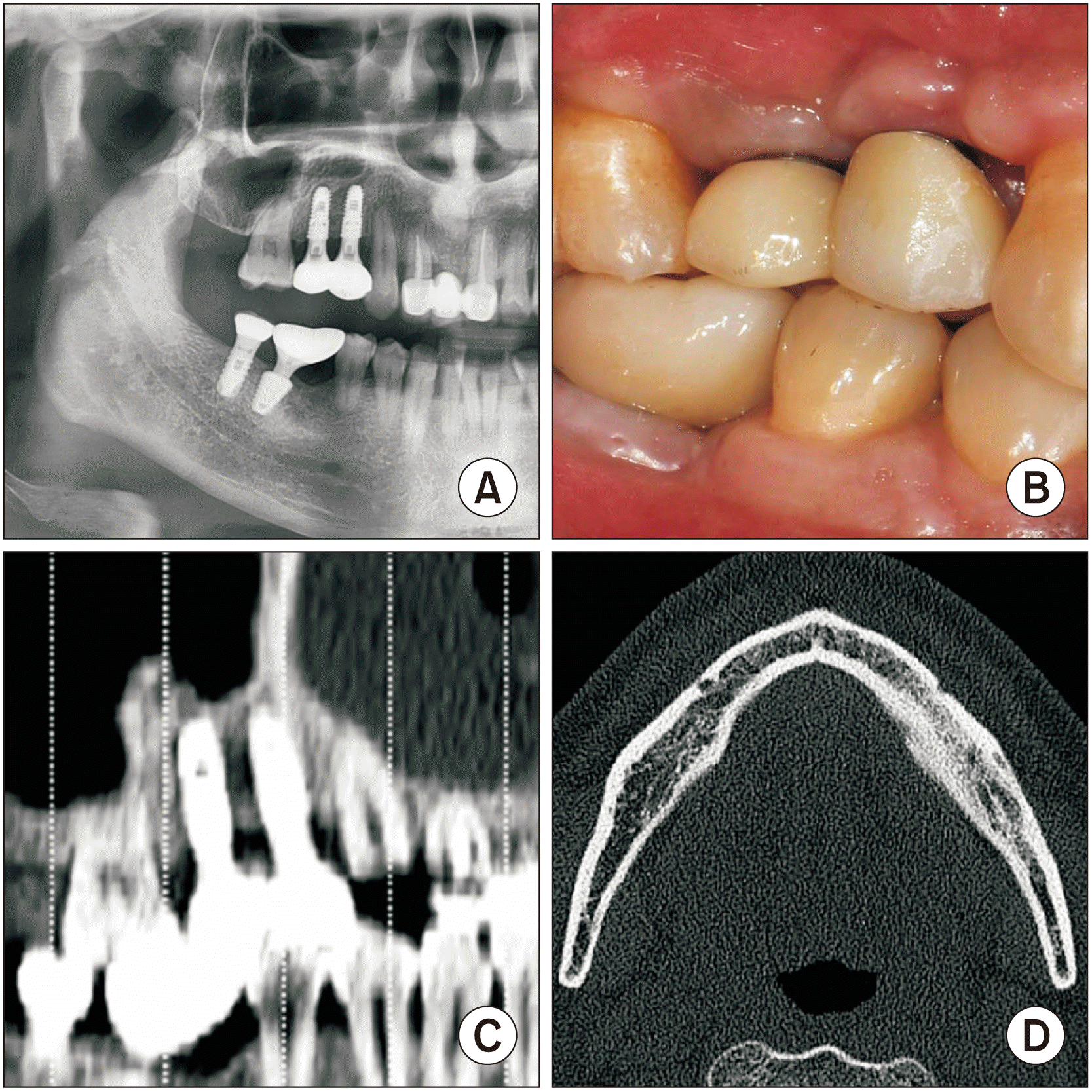Abstract
Autogenous bone grafts from the mandibular ramus are a known source of inadequate bone volume scenarios of the residual alveolar ridge. However, the conventional block-type harvesting technique cannot prevent bone marrow invasion, which can cause postoperative complications such as pain, swelling, and inferior alveolar nerve injury. This study aims to suggest a complication-free harvesting technique and present the results of bone grafting and donor sites. One patient received two dental implants with a complication-free harvesting technique that involves creation of ditching holes with a 1 mm round bur. Sagittal, coronal, and axial osteotomies produced grid-type cortical squares using a micro-saw and a round bur to confirm the cortical thickness. The grid-type cortical bone was harvested from the occlusal aspect, and the harvesting was extended through an additional osteotomy on the exposed and remaining cortical bone to prevent bone marrow invasion. The patient did not suffer postoperative severe pain, swelling, or numbness. After 15 months, the harvested site exhibited new cortical bone lining, and the grafted area had healed to a cortico-cancellous complex with functional loading of the implants. Our technique, grid-type cortical bone harvesting without bone marrow invasion, allowed application of autogenous bone without bone marrow invasion to achieve acceptable bone healing of the dental implants and to regenerate the harvested cortical bone.
Bone grafting has been used widely to repair bony defects for successful dental rehabilitation. Although various bone substitutes have been developed through tissue engineering, the gold standard for bone grafting remains autogenous bone, which has excellent biocompatibility, osteoconductivity, and osteoinductivity and contains living osteoblasts1. Autogenous bone grafts can provide support and stability to dental implants2,3 and maintain proper volume combined with the surrounding bone based on its osteoinductivity, and this supports timely bone regeneration4.
The mandible, which is an intramembranous bone, has reported minimal resorption and rapid integration compared to endochondral bone5. With regard to the extraoral donor site, mandibular harvesting for implant surgery has several advantages including the proximity and accessibility of the donor site, short operation time, patient satisfaction, and few complications6,7. Even in mandibular harvesting, the ascending ramus can be used for larger grafts8 with a lower possibility of complications compared to use of the symphysis9.
Nevertheless, surgeons may hesitate to perform ramus harvesting due to possible donor site complications such as morbidity, sensory disturbance, bleeding, and hematoma9,10. In a recent report of 216 patients who underwent ramus harvesting, 15.3% suffered from inferior alveolar nerve (IAN) disturbance immediately after the surgery3. Most of these complications occur during harvest through invasion of bone marrow with neurovascular complexes. If the surgeon can harvest the cortical bone without exposing the bone marrow, most of the complications can be avoided, and rapid bony remodeling is supported at the donor site. However, due to the complex mandibular curvature, it is difficult to harvest bone without damaging the bone marrow11.
Considering the abovementioned factors, we developed a ramus harvesting technique that can collect only cortical bone without resulting in bone marrow invasion. This study aims to suggest a complication-free harvesting technique and present the results of bone graft and donor sites.
This study was approved by the Institutional Review Board at the Armed Forces Capital Hospital (AFCH-20-IRB-035). The study was conducted according to the principles of the Declaration of Helsinki for research on humans.
The anterior part of the ascending ramus was exposed after mucoperiosteal flap elevation. To identify the cortical depth, ditching holes were created with a 1 mm round burr on the ascending branch of the ramus.(Fig. 1. A) Regarding the cortical thickness confirmed by round bur, the following procedures were performed with sagittal, coronal, and axial osteotomies using a micro-saw (Nouvag).(Fig. 1. B-E, Fig. 2) Sagittal osteotomy was performed using a sagittal micro-saw (0.4 mm blade thickness).(Fig. 1. B) Coronal osteotomy was created with parallel cuts using a micro-jigsaw (0.4 mm blade thickness) on the lateral part of the ramus over the height of contour.(Fig. 1) Two or three axial osteotomy lines were created using an oscillating micro-saw (0.4 mm blade thickness, 90° angle).(Fig. 1. D, Fig. 2. A)
Using a chisel and mallet, grid-shaped cortical squares were harvested from the occlusal grid level.(Fig. 1. E, Fig. 2. B) While confirming the thickness of the remaining cortical bone, additional osteotomies were created using the sagittal saw and harvested sequentially from the occlusal aspect.(Fig. 2. B) If the amount of collected bone was insufficient, harvesting could be extended through additional osteotomies to the adjacent cortical bone with consideration of cortical thickness to prevent bone marrow exposure.(Fig. 2. C, 2. D)
A 50-year-old male patient with controlled hypertension visited the clinic with loss of the right maxillary premolars (#14 and #15). Radiography revealed severe bone defects in the right maxilla.(Fig. 3) Reconstructive surgery with delayed implant placement was recommended using autogenous bone graft.
According to the above described method, the harvested grid-shape cortical bone was crushed by bone mill or crusher to easily manipulate and increase the contact area at the recipient site. To create a proper shape for implant placement, the grafts were fixed using titanium mesh (Retro Ti-matrix; seum medi) with two micro-screws (diameter 1.5 mm, 6 mm length; OsteoMed), and primary closure was completed after creating a releasing incision of the flap.(Fig. 4)
At removal of the titanium mesh after 5 months, successful integration of the grafted bone was verified, and two implants (diameter 4.0 mm, length 10 mm, TS III SA; Osstem) were placed without complications. The primary stability of both implants was verified (both ≥40 initial torque; 80 ISQ [implant stability quotient] value, Osstell; Integration Diagnostic AB), and a 1-stage protocol with a healing abutment connection was performed.(Fig. 5) Prosthetic loading was initiated at 5 months after implant placement. The marginal bone levels of the implants were stable at 15 months after surgery, and the grafted bone exhibited a cortico-cencellous complex. The harvested ramus area healed properly at the donor site on the mandibular ramus.(Fig. 6)
Dental implants have become the standard option for edentulous patients, and many bone substitutes have been developed for various alveolar defects. Autogenous bone has been used reliably to improve horizontal and vertical conditions for implant placement because of its osteogenetic properties, infection-resistant capacity, and secondary healing potential with wound dehiscence1. The mandibular ramus has been widely used for maxillofacial surgery due to its favorable characteristics6-8, in particular, the lower possibility of complications on the ramus compared to the symphysis9.
The common morbidities and complications associated with mandibular ramus harvest include nerve damage, pain, swelling, and postoperative bleeding12. Several studies have utilized the partial-thickness ramus block bone harvesting technique to avoid direct damage to the IAN10,13. Considering the 2.52-2.76 mm average thickness of cortical bone14, the previously mentioned technique could avoid direct nerve trauma. Block-type harvesting possesses a high risk of marrow exposure and indirect IAN paresthesia due to edema or hematoma from marrow exposure15, especially in patients with thin cortical bone or severe curvature of the lateral surface of the mandibular ramus. In our technique, the micro-saw could be applied to the vicinity of the marrow during osteotomy, and marrow exposure could be avoided due to the thickness of the grid-shape cortical block that could be controlled during harvesting. This avoided postoperative bleeding, hematoma, marrow edema, and compression to IAN and allowed rapid recovery of masticatory function and donor site regeneration after surgery.
Autogenous bone can exhibit resorption tendencies depending on the clinical conditions compared to other bone substitutes. In 2020, there was an average of 30% volume change at 1 year after implantation of 97 implants, but there was successful long-term follow-up implant success criteria of low marginal bone loss and high survival rate3. In particular, the volume of the grafted mandible was maintained without significant resorption compared to the iliac and tibial bones5. In this case report with crushed ramus cortical bone grafting, the grafted bone was successfully integrated for implant stability and maintained the bone level without marginal bone loss through 14 months.
In conclusion, our technique of grid-type cortical bone harvest without bone marrow invasion allowed application of autogenous bone without postoperative complications to achieve predictive bone grafting results for implant placement and to regenerate the harvested cortical bone. However, further studies should be conducted on the volume of the grafted ramus bone for long-term follow-up.
Notes
Authors’ Contributions
This research was made possible by the personal contributions of the following people: J.K.K. for writing the original draft preparation, M.S.G. for performing the image data curation, J.H.P. for reviewing and critical editing of the original draft, and D.H.L. for conceptualization and methodology. All authors have read and agreed to the published version of the manuscript.
References
1. Kim YK, Ku JK. 2020; Ridge augmentation in implant dentistry. J Korean Assoc Oral Maxillofac Surg. 46:211–7. https://doi.org/10.5125/jkaoms.2020.46.3.211. DOI: 10.5125/jkaoms.2020.46.3.211. PMID: 32606284. PMCID: PMC7338632.

2. Bell RB, Blakey GH, White RP, Hillebrand DG, Molina A. 2002; Staged reconstruction of the severely atrophic mandible with autogenous bone graft and endosteal implants. J Oral Maxillofac Surg. 60:1135–41. https://doi.org/10.1053/joms.2002.34986. DOI: 10.1053/joms.2002.34986. PMID: 12378486.

3. Jang K, Lee JH, Oh SH, Ham BD, Chung SM, Lee JK, et al. 2020; Bone graft materials for current implant dentistry. J Dent Implant Res. 39:1–10. https://doi.org/10.54527/jdir.2020.39.1.1. DOI: 10.54527/jdir.2020.39.1.1.

4. Rogers GF, Greene AK. 2012; Autogenous bone graft: basic science and clinical implications. J Craniofac Surg. 23:323–7. https://doi.org/10.1097/scs.0b013e318241dcba. DOI: 10.1097/SCS.0b013e318241dcba. PMID: 22337435.

5. Zins JE, Whitaker LA. 1983; Membranous versus endochondral bone: implications for craniofacial reconstruction. Plast Reconstr Surg. 72:778–85. https://doi.org/10.1097/00006534-198312000-00005. DOI: 10.1097/00006534-198312000-00005. PMID: 6196801.

6. Lee HG, Kim YD. 2015; Volumetric stability of autogenous bone graft with mandibular body bone: cone-beam computed tomography and three-dimensional reconstruction analysis. J Korean Assoc Oral Maxillofac Surg. 41:232–9. https://doi.org/10.5125/jkaoms.2015.41.5.232. DOI: 10.5125/jkaoms.2015.41.5.232. PMID: 26568924. PMCID: PMC4641213.

7. Cha HS, Kim JW, Hwang JH, Ahn KM. 2016; Frequency of bone graft in implant surgery. Maxillofac Plast Reconstr Surg. 38:19. https://doi.org/10.1186/s40902-016-0064-2. DOI: 10.1186/s40902-016-0064-2. PMID: 27077072. PMCID: PMC4819798.

8. Güngörmüş M, Yavuz MS. 2002; The ascending ramus of the mandible as a donor site in maxillofacial bone grafting. J Oral Maxillofac Surg. 60:1316–8. https://doi.org/10.1053/joms.2002.35731. DOI: 10.1053/joms.2002.35731. PMID: 12420267.

9. Reininger D, Cobo-Vázquez C, Monteserín-Matesanz M, López-Quiles J. 2016; Complications in the use of the mandibular body, ramus and symphysis as donor sites in bone graft surgery. A systematic review. Med Oral Patol Oral Cir Bucal. 21:e241–9. https://doi.org/10.4317/medoral.20938. DOI: 10.4317/medoral.20938. PMID: 26827063. PMCID: PMC4788806.

10. Hwang KG, Shim KS, Yang SM, Park CJ. 2008; Partial-thickness cortical bone graft from the mandibular ramus: a non-invasive harvesting technique. J Periodontol. 79:941–4. https://doi.org/10.1902/jop.2008.070408. DOI: 10.1902/jop.2008.070408. PMID: 18454675.

11. Bayome M, Park JH, Kook YA. 2013; New three-dimensional cephalometric analyses among adults with a skeletal class I pattern and normal occlusion. Korean J Orthod. 43:62–73. https://doi.org/10.4041/kjod.2013.43.2.62. DOI: 10.4041/kjod.2013.43.2.62. PMID: 23671831. PMCID: PMC3650215.

12. Clavero J, Lundgren S. 2003; Ramus or chin grafts for maxillary sinus inlay and local onlay augmentation: comparison of donor site morbidity and complications. Clin Implant Dent Relat Res. 5:154–60. https://doi.org/10.1111/j.1708-8208.2003.tb00197.x. DOI: 10.1111/j.1708-8208.2003.tb00197.x. PMID: 14575631.

13. Kim SG, Song JY, Lee YC. 2011; Modified veneer bone graft with the concomitant installation of a dental implant: technical note. Oral Maxillofac Surg. 15:189–92. https://doi.org/10.1007/s10006-011-0271-z. DOI: 10.1007/s10006-011-0271-z. PMID: 21503623.

14. Leong DJ, Li J, Moreno I, Wang HL. 2010; Distance between external cortical bone and mandibular canal for harvesting ramus graft: a human cadaver study. J Periodontol. 81:239–43. https://doi.org/10.1902/jop.2009.090417. DOI: 10.1902/jop.2009.090417. PMID: 20151802.

15. Doh RM, Shin S, You TM. 2018; Delayed paresthesia of inferior alveolar nerve after dental surgery: case report and related pathophysiology. J Dent Anesth Pain Med. 18:177–82. https://doi.org/10.17245/jdapm.2018.18.3.177. DOI: 10.17245/jdapm.2018.18.3.177. PMID: 29984322. PMCID: PMC6031975.

Fig. 1
Schematics of the ramus harvesting technique without bone marrow invasion. A. Ditching holes created with a 1 mm round bur on the ascending branch of the ramus. B-D. Regarding the cortical thickness confirmed by a round bur, the following procedures were completed with sagittal (B), coronal (C), and axial osteotomies (D) using a micro-saw. E. Harvesting grid-shaped cortical squares.

Fig. 2
Intraoperative images of the ramus harvesting technique without bone marrow invasion. A. Formation of ditching holes with a 1 mm round bur was followed by osteotomies was made using the micro-jigsaw and sagittal and oscillating micro-saws. B. After harvesting on the most occlusal aspect, osteotomies were created on the cortical bone. C. Additional harvesting was performed without bone marrow exposure. D. Harvesting of only cortical bone was confirmed by postoperative computed tomography.

Fig. 3
Preoperative radiograph. Severe bone defect and sinus pneumatization were observed on the right maxilla. A. Panoramic X-ray. B. Panoramic section on computed tomography.

Fig. 4
Bone graft surgery. A. The harvested grid-type cortical bone. B. The crushed cortical bone. C. The grafted cortical bone with titanium mesh.

Fig. 5
Bone healing 5 months after grafting. A. Removal of the titanium mesh. B. The bone healing was enough to obtain primary stability of the dental implants. C. The dental implants were placed with a 1-stage protocol.

Fig. 6
Images at 15 months after grafting. A. The dental implants were well-maintained during 10 months after prosthetic loading. B. Well-functioning dental implants and healthy gingiva. C. The grafted cortical bone exhibited a cortico-cancellous pattern with remodeling. D. The harvested cortical bone was regenerated.





 PDF
PDF Citation
Citation Print
Print



 XML Download
XML Download